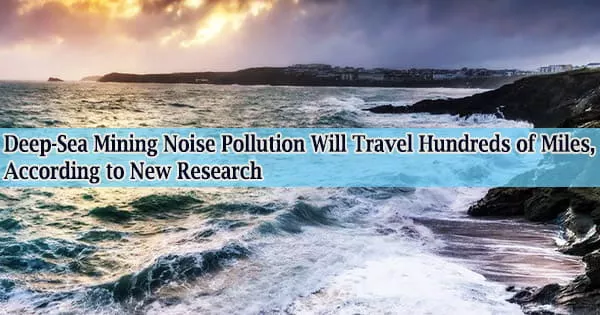The largest habitat on Earth’s surface, the deep sea, is home to a variety of understudied species that could be harmed by underwater noise pollution from seabed mining operations, according to new research published today in the peer-reviewed journal Science.
The Pew Charitable Trusts funded a study by researchers from the Oceans Initiative, the National Institute of Advanced Industrial Science and Technology (AIST) in Japan, Curtin University in Australia, and the University of Hawaii that found noise from a single mine could travel up to 500 kilometers (311 miles) in calm weather, with cumulative effects likely in areas where there are several mines operating.
Numerous species of animals that are only found in the deep sea use sound to travel, communicate, find mates, find food, and detect predators and other threats. This is because there is no sunlight in the deep sea.
The Clarion-Clipperton Zone (CCZ), which spans 4.5 million square kilometers (1.7 million square miles) between Hawaii and Mexico and is a major focus of deep-sea mining interest, is being investigated for mining potential by seventeen contractors.
An estimated 5.5 million square kilometers (2.1 million square miles), or an area greater than the European Union, would experience increased noise levels if each of the contractors launched just one mine.
This degree of mining activity may not only negatively affect species that are sensitive to noise, but it may also jeopardize efforts to protect “preservation reference areas,” or places that have not been affected by mining and are used as a basis for scientific comparisons.
“What surprised me most was how easy it would be for noise from just one or two mines to impact nearby areas that have been set aside as experimental controls,” said Rob Williams, co-founder of Oceans Initiative.
“With so many unknowns, we need a careful comparison of these preservation reference areas to sites where mining is taking place in order to understand mining’s impacts. But the noise will cross the boundaries between preservation zones and mining sites.”
Estimating the noise of future equipment and installations is a challenge, but we don’t have to wait until the first mines are operational to discover the noise they make. By identifying the level of noise in the engineering design phase, we can better prepare for how this might impact marine life.
Professor Christine Erbe
Added Craig R. Smith, a professor emeritus at the University of Hawaii, “Our modeling suggests that mining noise could impact areas far beyond the actual mining sites, including preservation reference zones, which are required under draft mining regulations to be unaffected by mining.”
This finding, he said, “could require a rethinking of environmental regulations, including the number of mining operations allowed within the CCZ.”
Although deep-sea mining system prototypes at lesser scales are already being tested by mining corporations, they have not yet disclosed their findings about underwater noise pollution. As a result, the Science publication had to substitute noise levels from more thoroughly researched industrial activity, like ships for the oil and gas industry and coastal dredges.
Once the data is available, the actual noise levels from deep-sea mining may differ, but according to Andrew Friedman, project director of Pew’s seabed mining project, they are more likely to be higher than the proxy data than lower because the real equipment used for seabed mining is much larger and more potent than the proxies. “These are probably conservative estimates.”
Christine Erbe, a professor at Curtin University, said, “Estimating the noise of future equipment and installations is a challenge, but we don’t have to wait until the first mines are operational to discover the noise they make. By identifying the level of noise in the engineering design phase, we can better prepare for how this might impact marine life.”
The island nation of Nauru invoked a United Nations resolution two years ago that could compel the International Seabed Authority, the intergovernmental body that oversees all mineral activities in areas outside of national jurisdiction, to complete regulations allowing large-scale mining by July 2023 or refrain from considering mining proposals in the absence of such regulations.
The action was taken despite worries from governments, businesses, and civil society organizations that the science and governance around deep-ocean mining remain insufficient. The Science study adds to a growing body of research that indicates it is unlikely that sufficient data will be gathered to evaluate the ecological consequences from mining noise by the deadline in July 2023.
In light of this, an increasing number of nations, professionals, businesses, and environmental organizations are urging a halt to all seabed mining until such time as research and management can be implemented to ensure that mining will not negatively impact the marine environment.
Pew’s Friedman said that the study “highlights how much remains unknown about mining’s potential impacts, not just on the deep ocean, but throughout the water column.”
“The deep sea houses potentially millions of species that have yet to be identified, and processes there allow life on Earth to exist,” said Travis Washburn, a deep-sea ecologist at AIST.
“While much work is still needed to determine the extent and magnitude of environmental impacts from deep-sea mining, with careful study and management we have a unique opportunity to understand and mitigate human impacts to the environment before they occur.”





